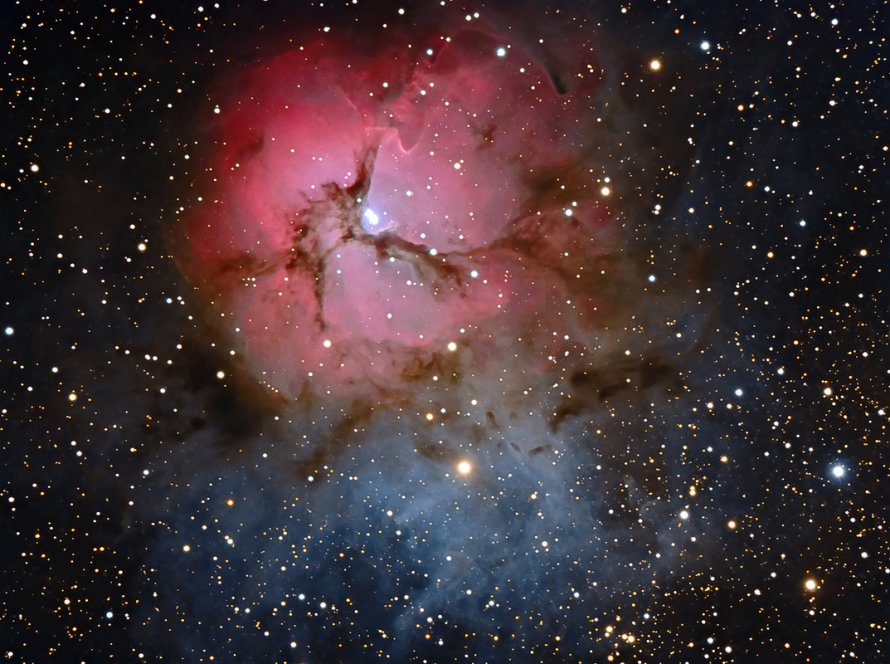M20 (NGC 6514) - Trifid Nebula
Messier 20 (NGC 6514), also known as the Trifid Nebula, is a nebula w/cluster located in the constellation Sagittarius, in the Sagittarius Arm of the Milky Way Galaxy in the Local Group of galaxies. M20 is 4000 light years away from Earth.
M20 is best viewed during late summer, is magnitude 6.3, and can be viewed with binoculars. M20 is 28' in apparent size. For reference, the full moon is 30'.
Observing difficulty: Easy
- Name:
- Trifid Nebula
- Type:
- nebula w/cluster
- Constellation:
- Sagittarius
- NGC or IC:
- NGC 6514
- Magnitude:
- 6.3
- Viewing:
- binoculars
- Size:
- 28'
- Distance (light years):
- 4000 LY
- RA:
- 18h 2.3m
- Dec:
- -23 2'
- Season:
- late summer
- Milky Way location:
- Sagittarius Arm
- Galaxy group:
- Local Group
- Messier Marathon #:
- 97
- Contains:
- Barnard 80 dark nebula
* The naked eye can see up to magnitude ~7-8 objects under ideal dark sky conditions.
The Majestic Trifid Nebula
Messier 20, commonly known as the Trifid Nebula, is a celestial gem nestled within the Milky Way's dense star fields in the constellation Sagittarius. Famous for its striking appearance and the variety of astronomical phenomena it hosts, the Trifid Nebula offers a captivating observational target for amateur astronomers. In this article, we delve into the nebula's discovery, its physical attributes, stellar population, its brightness, and guidance on locating and observing it.
Discovery and Observation
Discovered by Charles Messier in 1764, the Trifid Nebula, located about 5,000 light-years away, offers an exquisite sight through a telescope. The nebula's complex structure and varying colors, owing to its composition, make it an intriguing object of study and observation.
Physical Characteristics and Magnitude
M20 is an unusual combination of three nebula types - an emission nebula, a reflection nebula, and a dark nebula - which gives it the name 'Trifid'. The nebula spans across 40 light-years and has an apparent magnitude of 6.3, making it a challenge to observe without optical aid. The rich red hue of the emission nebula, the blue tints of the reflection nebula, and the contrasting dark lanes that appear to divide the nebula into three parts, are best appreciated with a moderate to large-sized telescope.
Stellar Composition
At the heart of M20 is a young, hot, massive star that generates strong ultraviolet radiation, causing the surrounding gas to glow brightly. This star is believed to be a mere 300,000 years old, an infant by cosmic standards. Furthermore, M20 is an active stellar nursery, where new stars are being formed, making it an interesting object for scientists studying stellar evolution.
Astronomical Significance
The Trifid Nebula serves as an invaluable laboratory for studying star formation processes due to its active stellar nursery. Its unique combination of three nebula types in one location also makes it particularly interesting for the study of nebular physics and the interactions between newborn stars and their parent nebulae.
Finding and Viewing M20
Finding M20 involves first locating the constellation Sagittarius. It is best viewed during summer months in the Northern Hemisphere. The nebula is situated north of the famous Teapot asterism and is located close to M21, an open star cluster. Under dark skies, M20 can be spotted with binoculars as a faint, fuzzy patch, while a telescope reveals its distinctive colors and structures. Because of its low surface brightness, it's easier to observe from a dark location away from city lights.



